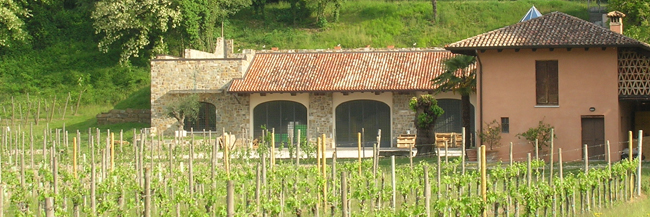
When Pinot Grigio (grey Pinot) is left on the vine until fully ripe the skin takes on a dark pinkish hue. Maceration with the skins then results in a copper colored wine, which is traditionally called 'Ramato.' Ramato (rama means copper in Italian) is the traditional style of production for Pinot Grigio in Friuli. In fact, before 1970 all Pinot Grigio produced in Friuli was made in the ramato style.
The Bellanotte Pinot Grigio is produced from fruit sourced 100% within Friuli's Collio appellation from vines whose average age is 60 – 85 years.. After de-stemming, the juice is left on the skins in steel tanks for three days. After fermentation, the wine is matured 50% in stainless steel and 50% in 500 liter barrels, 1/3 new, 1/3, one year old and 1/3 two year old, for four months and then held in bottle.
The Bellanotte Pinot Grigio exhibits a beautiful, copper color with luminescent clarity. The lush aromas include wild strawberry, elderberry, hay and dried roses with hints of dried fruits and almond. A beautiful balance of robust fruit and crisp acidity characterize the complex palate with flavors that mirror the notes found in the wine's bouquet. The Conte Lucio Pinot Grigio is a unique wine that offers a singular expression of the Pinot Grigio grape.
Total production 600 cases
Picolit was found widely on royal and aristocratic tables all over Europe up to the middle of the 18th century, and was often said to be on a par with Château d´Yquem. In the Colli Orientali del Friuli Picolit was classified as DOCG in April 2006 giving Picolit the deserved status, as one of the great wines of Italy. The minimum alcohol content is 15% vol., and 16% and the maximum permitted yield is 22 hectoliters per hectare.
Picolit plantings may possibly grow in the coming years, but the expansion will never be dramatic. Picolit is a difficult and labor intensive variety. The main problem for growers is that two types of flowers are formed during flowering. One of them is not pollinated and doesn't produce grapes. Thus, Picolit bunches are formed loose, as if many berries are missing. If a normal bunch consists of 30-100 berries, Picolit has only 15-30. Natural yields, accordingly, are very low, maximum 3-4 tons per hectare. The other difficulty with Picolit is that its vines are very vigorous and require a lot of time and labor to bring the fruit to harvest.
La Bellanotte's Picolit is a definitive example of what can be achieved from the tiny cultivation of this prized grape within Friuli. While the law stipulates that Picolit can be produced with a blend of 85% Picolit grapes, La Bellanotte's Picolit is produced from 100% Picolit grapes. They are dried on reed mats in special, cool, ventilated "houses" for three month after harvest. The grapes are de-stemmed manually and then undergo a soft pressing and fermentation in 120 liter, French oak barrels for 30 days, followed by barrel aging.
The Bellanotte Picolit has a beautiful, antique gold color with streaks of topaz. It offers an intense and evocative bouquet with notes of apricot jam, candied orange peel, dates, almonds, roasted figs, raisins, cardamom, white pepper and hint of smoke and flint. The taste is enticing sweet, yet supported by an excellent balance of acidity and finishes with great length on the palate.
Extremely rich and lush in the mouth, the Bellanotte Picolit envelops the palate with seductive, intense, complex flavors of toasty, sweet, dried fruit, apricot, almond and exotic spices. It serves beautifully with classic dessert wine pairings but is best served with reverence, alone, after a meal.
Total production 500 bottles 375ml